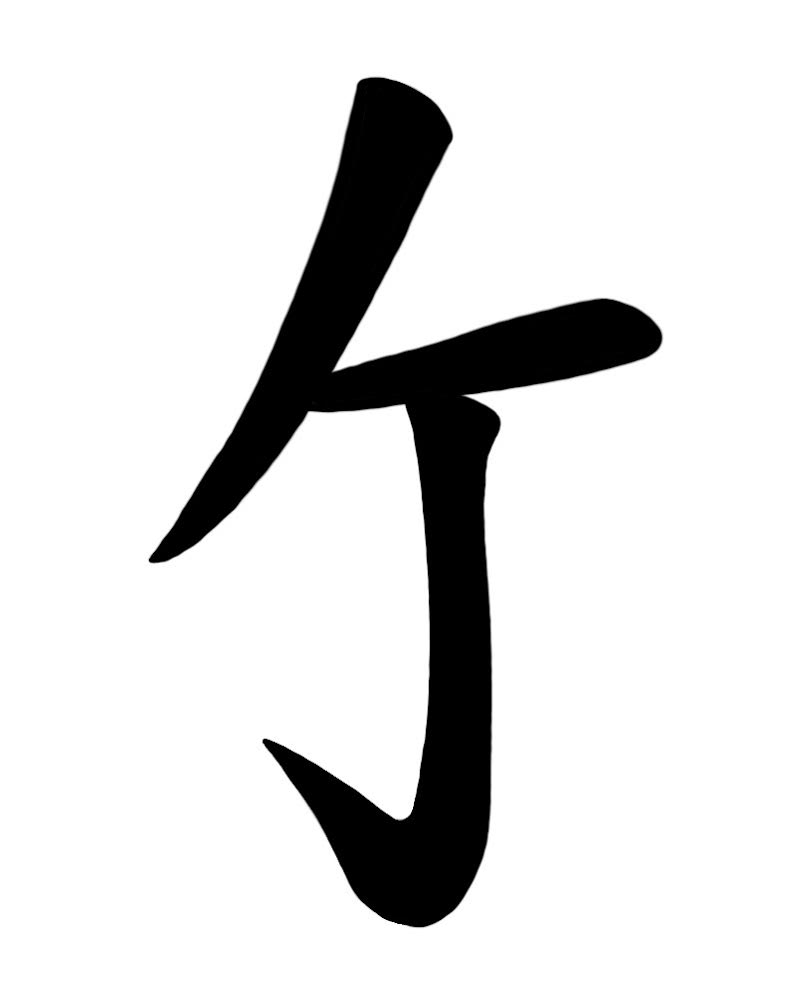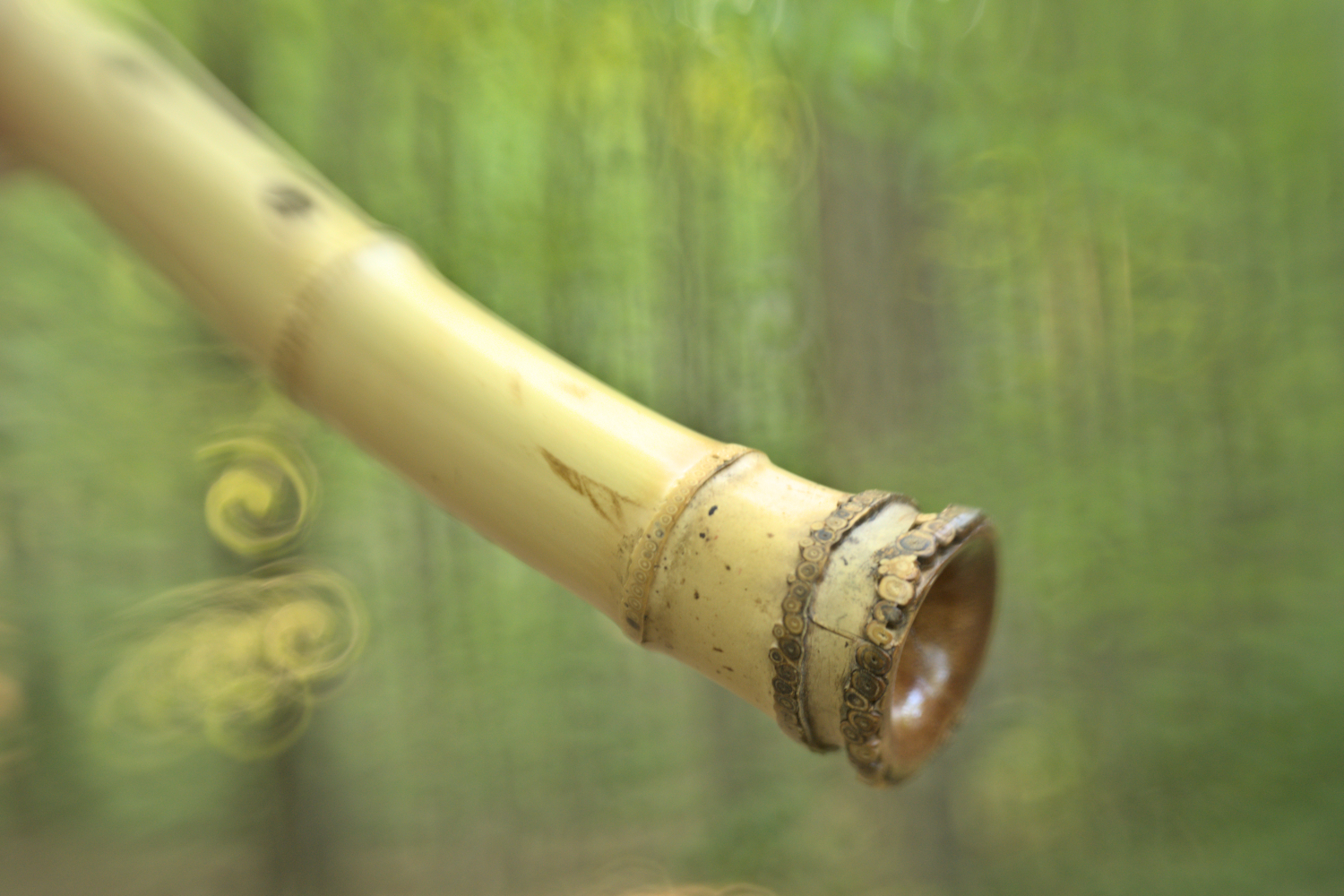Japanese Madaké Bamboo for Shakuhachi — A trip into the Grove
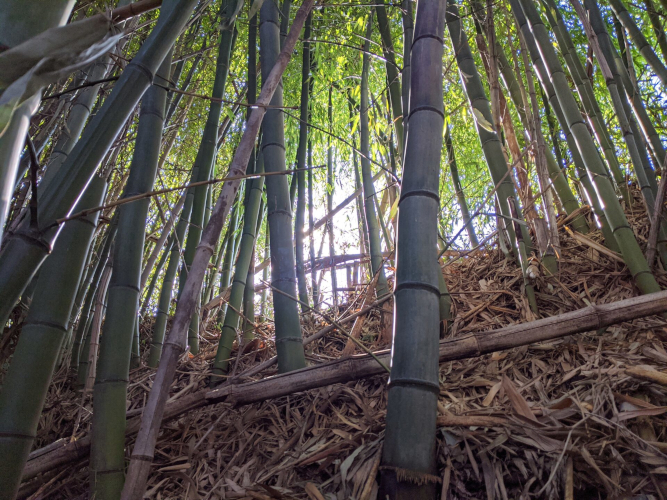
For years, I have pursued prime Madaké bamboo in countless groves, seeking the perfect pieces for my shakuhachi. Each time I step into these towering emerald cathedrals, I transcend time and place. I am dwarfed by bamboo giants, living testaments to life’s resilience on Earth. Potential shakuhachi sway around me, vibrant and alive, yet their eight-year lifespan also serves as a profound reminder of life’s transience.
The Spirit of Bamboo Embodied in Shakuhachi
Observing living Madaké bamboo reveals how truly the shakuhachi embodies its essence. We hold the instrument upright, roots-down, mirroring bamboo’s natural growth. With no small effort, bamboo generously offers us an infinite variety of shakuhachi. I invite you to accompany me into the Madaké grove as I share the wonders of this remarkable grass — both the ‘how’ and ‘why’ shakuhachi makers like me utilize it.
Videos of me harvesting Japanese Madaké Bamboo for shakuhachi
(The videos above show me harvesting Madaké Japanese bamboo, or také hori. They also show me processing the bamboo, including performing Aburanuki or “heat curing”. These short films condense hours, days, or even weeks of my labor into just minutes.)
Madaké 真竹, Banzhu 斑竹, Phyllostachys bambusoides, Giant Japanese timber bamboo — A rose by any other name
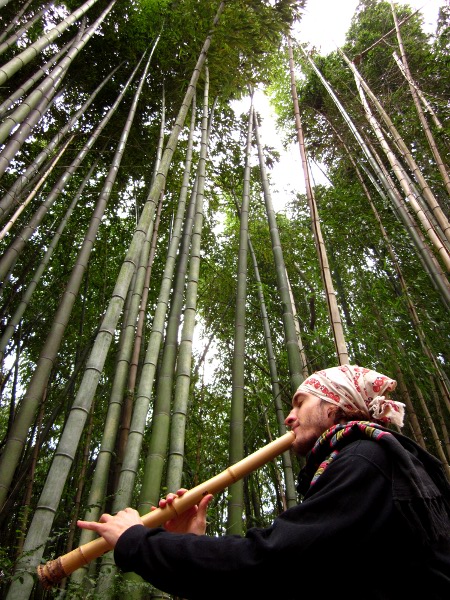
For over a millennium, craftspeople like me have primarily chosen Madaké (真竹, Phyllostachys bambusoides), also known as Giant Japanese timber bamboo, for crafting shakuhachi. Its favorable characteristics and abundance in Japan made it ideal. Like many elements of Japanese culture, its origins trace back to China, with the first live plants imported during the Nara period (710-794 AD) from Zhejiang province.
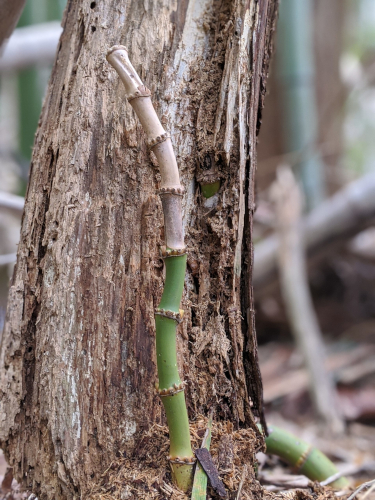
Interestingly, Madaké bamboo worldwide shares the exact same DNA, reproducing asexually directly from its roots, or rhizomes. These rhizomes are like subterranean dragons, snaking and knitting through the soil, sometimes bursting forth, often diving back down, but always forging ahead.
From these subterranean “wombs,” each stalk emerges as a new shoot. Soon, it breaches the earth, climbs toward the heavens, and fans out its leaves like an umbrella, transforming light into life. The entire grove functions as one tightly interconnected collective. When we harvest a piece, the whole grove, in a sense, knows it. Remarkably, every hundred years, Madaké stalks globally flower at the exact same time, and then die. The last such event, in the 1960s, profoundly impacted the Japanese craft world. Thankfully, the rhizomes survive.

It is astonishing how these new shoots can telescope to their full height and nearly full girth within just a few months. Some shoots are as wide as a human thigh, making one feel like a small insect. Madaké is indeed a “giant” bamboo, naturally striving for immense size. Under ideal growing conditions, few stalks remain the correct size for shakuhachi. Over each growing season, these new stalks develop limbs and leaves until they reach three to four years of age. What often surprises people is that these majestic stalks typically only live for about eight years.
Why Madaké for Shakuhachi?
We shakuhachi craftspeople highly favor Madaké bamboo because it generally grows very straight, with excellent internodal spacing ideal for finger-hole placement. The lower portion we use can also possess a desirable inner taper, crucial for the correct shakuhachi sound and feel.
However, we do experiment with other bamboo species and even alternative materials. For example, I have found certain sub-varieties of Madaké can excel for crafting shakuhachi. In fact, one rare sub-variety I have used consistently yields objectively superior-sounding Jinashi and Jimori instruments. It is also possible to craft very fine shakuhachi from above-root bamboo.
Historically, Japanese makers did not widely use the root end until nearly a thousand years after the shakuhachi’s introduction from China. While crafting without the roots is certainly possible, the root-end’s distinct, bell-like silhouette has become the quintessential hallmark of the shakuhachi.
Harvesting Madaké bamboo for crafting shakuhachi
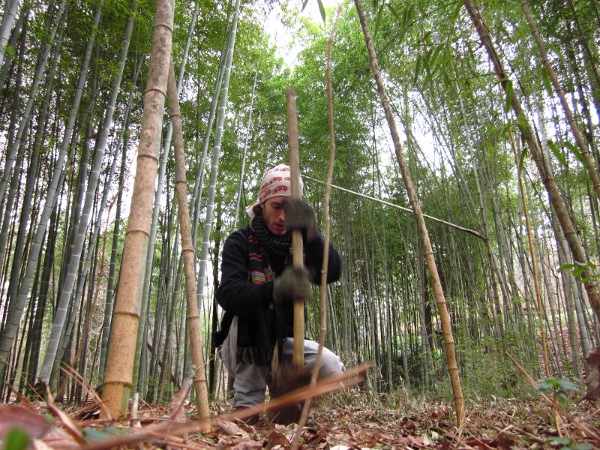
I began harvesting my own bamboo for flutes around 2001-2002, when I was fifteen or sixteen. Back then, I lived between Florida and Norfolk, Virginia, USA. Both states are teeming with amazing bamboo groves. Of course, I have also harvested Madaké bamboo in Japan. Every grove is unique, yet each feels profoundly like home.
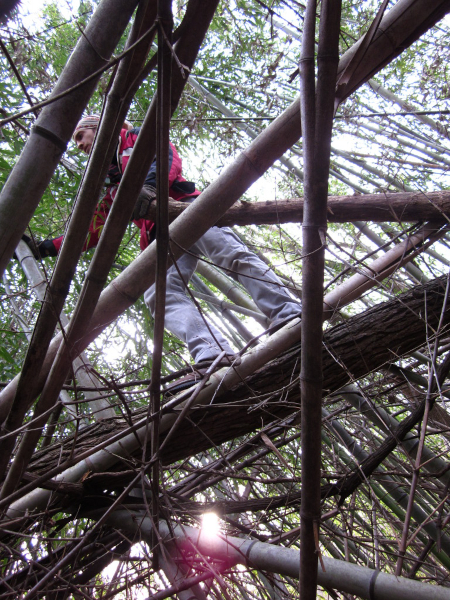
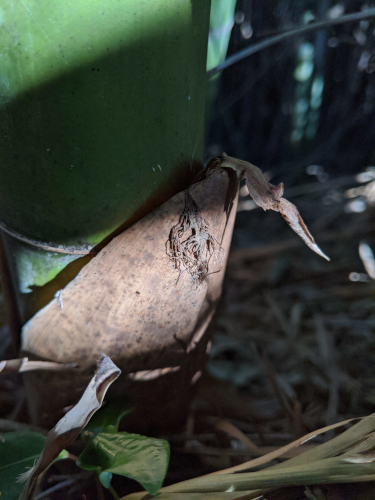
Before harvesting, I occasionally need to positively identify the bamboo as Madaké, as species like Vivax and Makino can appear nearly identical. I prefer to identify shoots in spring when they are budding, but a dead shoot can also suffice. Madaké shoots are notably smooth and waxy, leopard-spotted, with bright pink leaf tips. Most distinctly, they possess vivid green, spider-like “auricles” which are truly magical to behold. Makino shoots look similar but are darker and covered in coarse hairs. Vivax and Hachiku (blue henon) shoots, conversely, lack auricles.

Next, I spend many hours meticulously searching the grove for suitable pieces. I like to get a feel for the entire grove, if possible, before I begin to dig. After carefully considering potential stalks, I dedicate many more hours to unearthing them. This is no easy feat. Beyond the bamboo stalk’s own roots, I must contend with immensely tough rhizomes. These unbelievably hard, solid rhizomes have shattered my tools on more than one occasion. On a harvesting trip to Japan, for instance, my “indestructible” “Slammer” tool unexpectedly broke against a rhizome.

While it might initially seem harsh to remove living bamboo stalks, it is akin to harvesting a vegetable. For shakuhachi, we primarily select older, dying, or dead stalks. This practice, known as culling, actually helps maintain the overall health of the bamboo grove. Removing these stalks prevents overcrowding, makes way for new growth, and helps stave off infections and infestations.
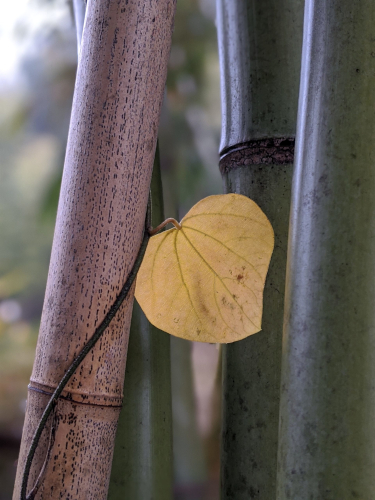
As mentioned, the average lifespan of a single Madaké stalk is only about eight years. The ideal harvesting age is from four years onward. As they begin to die, harmless fungi can create beautiful mottled splotches or “spalting,” which many shakuhachi enthusiasts cherish. In Japan, these spalted pieces of Madaké are called “goma,” translating to “sesame seeds,” after the small bumps of dried sap that often form on the bamboo’s skin (see picture above). Indeed, some renowned shakuhachi makers intentionally bury their bamboo in fungi-rich mediums or even chicken manure to induce spalting (a process also practiced in the West for spalted wood).
Harvesting in Winter — Safety in the Season
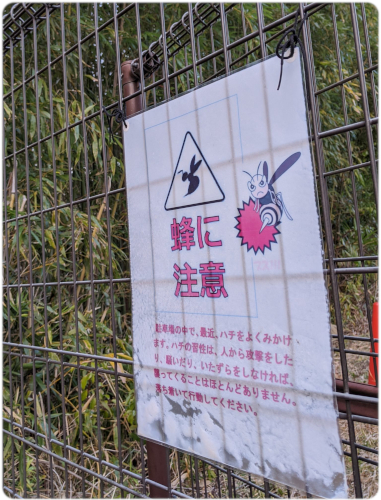
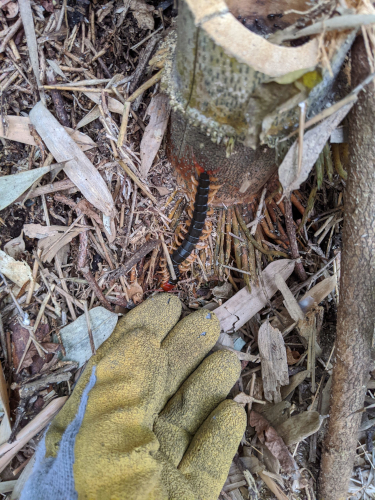

We harvest bamboo primarily in winter because potentially dangerous insects and other creatures are largely (hopefully) dormant. Wild boars are also less active during winter, as are venomous snakes in other parts of the world, like North America. Of course, all the inherent dangers of hard manual labor with sharp tools are present when harvesting Madaké. Additionally, in winter, the bamboo tends to be more dormant with less water content, which significantly speeds up the initial drying process and reduces the likelihood of cracking. Similarly, the mild winter sun provides a more consistent drying environment, further minimizing the risk of cracks.
Fire Curing or Aburanuki
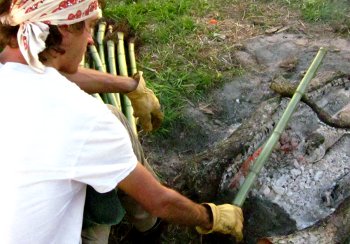
There is nothing quite like the smell of cooking green Madaké bamboo. After many long hours of harvesting, transporting, and cleaning, the time finally comes for the next magical process in shakuhachi construction: Aburanuki. Aburanuki is the act of “sweating” the bamboo over a heat source. This drives out moisture and cooks the natural juices within the bamboo, making them more viscous, almost like a natural glue. This process, in turn, helps the bamboo dry faster, makes it somewhat stronger, and ideally less prone to cracking.
Following Aburanuki, I place my bamboo in full sunlight to dry for a month or more, meticulously rotating each piece for even exposure. After this sun-drying phase, I move the bamboo indoors for a further “curing” period of at least three years but often five years or more. (Working the bamboo too soon can cause issues like gumming up tools.)
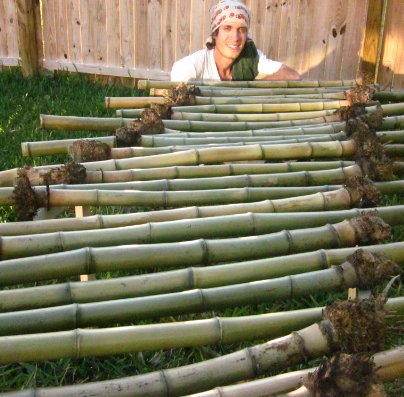
A Shared Appreciation
In conclusion, I hope you have enjoyed this walk through the bamboo grove with me. You have now emerged with a deeper understanding of this rarified craft and an even greater respect for bamboo itself. You can see one of my most recent harvesting trips to Japan in my journal entry here or read about my odyssey with Japanese Madaké growing in North America here.
